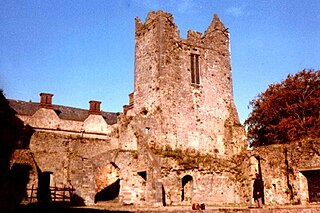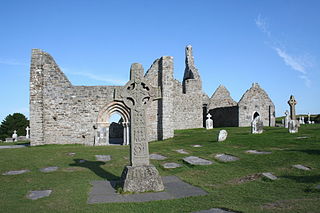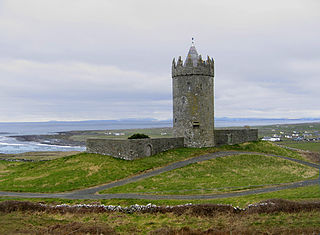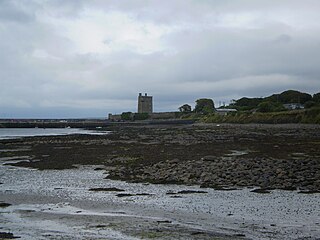
Ross Castle is a 15th-century tower house and keep on the edge of Lough Leane, in Killarney National Park, County Kerry, Ireland. It is the ancestral home of the Chiefs of the Clan O'Donoghue, later associated with the Brownes of Killarney.

Ormond Castle is a castle on the River Suir on the east side of Carrick-on-Suir, County Tipperary, Ireland. The oldest part of the existing castle is a mid-15th century walled bawn, cornered on the northeast and northwest by towers.

Banagher is a town in Ireland, located in the midlands, on the western edge of County Offaly in the province of Leinster, on the banks of the River Shannon. It had a population of 3,000 at the height of its economic growth in the mid-19th century; as of 2016, the population was over 1,700.

Clonmacnoise is a ruined monastery situated in County Offaly in Ireland on the River Shannon south of Athlone, founded in 544 by Saint Ciarán, a young man from Rathcroghan, County Roscommon. Until the 9th century it had close associations with the kings of Connacht.

Doonagore Castle is a round 16th-century tower house with a small walled enclosure located about 1 km south of the coastal village of Doolin in County Clare, Ireland. Its name may be derived from Dún na Gabhair, meaning "the fort of the rounded hills" or the "fort of the goats". Doonagore Castle is at present a private holiday home, inaccessible to the public.
Lusmagh is a civil parish in County Offaly, Ireland, bounded by three rivers: the Shannon, Lusmagh and Little Brosna to the west, east and south respectively. The town of Banagher is northeast across the River Lusmagh. Lusmagh was considered part of County Galway in 1628 and Connacht until 1373; the Lusmagh Roman Catholic parish is the only one in the Diocese of Clonfert east of the Shannon. According to the history of the O'Kellys of Hy-Many, Lusmhaigh means the plain of the healing herbs. In Christian times, the parish was named Cill Mochonna, "the Church of Mo Chua". Saint Mo Chua of Balla, also called Crónán, founded a monastery in 600 on the site of Cloghan Castle. The name Lusmagh was restored to the Catholic parish around 1810. Its parish church, named after St. Crónán, is about three miles southwest of Banagher.

Carrigaholt is a small fishing village in County Clare, Ireland, a castle and a Catholic parish by the same name. The area was officially classified as part of the West Clare Gaeltacht; an Irish-speaking community; until 1956.
Meelick, also Milic, is a townland on the River Shannon in Ireland. It lies approximately 4 km southeast of Eyrecourt in County Galway.It is best known for its walkway that connects to Lusmagh (Offaly). It also holds the oldest church still in use in Ireland at 608 years old given papal permission and built in 1414 AD it is also within the Parish of Clonfert which is home to the madonna statue Our Lady of Clonfert. Clonfert is the head of its diocese with its headquarters home to Most Rev. Bishop Michael Duignan, St. Brendans Presbytery Loughrea. It is home to the oldest hurling club in Ireland which was founded in 1884. It has a little pub 10 yards from The Church known locally as “George’s/The Shop” It holds a kayaking festival each year after the boating season halts to its winter end with a great quay half way between Portumna and Banagher home to SilverLine Cruisers, CarrickCraft and Emerald Star-line. It holds a car rally in association with Galway Rally ever few years. Its current Parish Priest (2021) is REV.Fr.Declan McInerney PP.

Parke's Castle is a plantation era castle situated on the northeast shore of Lough Gill, in County Leitrim, Ireland. The castle is built on the site of an earlier fifteenth-century O'Rourke tower house. The building came into the possession of Robert Parke in late 1628. By 1635 Parke had completed his fortified manor house on the site of the older Gaelic castle.

Ballinalacken Castle is a two-stage tower house located in Killilagh parish of County Clare, Ireland. It is of uncertain date but most likely was built in the 15th or early 16th century.

Rockstown Castle is a ruined Irish tower house from medieval times in County Limerick, Ireland. It is located near the village of Ballyneety, 7 miles (11 km) from the city of Limerick.

Tower houses appeared on the Islands of Ireland and Great Britain starting from the High Middle Ages. They were constructed in the wilder parts of Great Britain and Ireland, particularly in Scotland, and throughout Ireland, until at least up to the 17th century. The remains of such structures are dotted around the Irish and Scottish countryside, with a particular concentration in the Scottish Borders where they include peel towers and bastle houses. Some are still intact and even inhabited today, while others stand as ruined shells.

Moorstown Castle is a late 15th-century stone structure consisting of an enclosed circular keep near Clonmel, County Tipperary, Ireland.

Gleninagh or Glaninagh is a civil parish in County Clare, Ireland. It lies in the extreme northwest of the Burren, on the south of the mouth of Galway Bay. It is known for the well-preserved L-plan Gleninagh Castle, a 16th-century tower house. The parish also contains the lighthouse on Black Head.

Garrycastle is a barony in County Offaly, Republic of Ireland.

Rathmacknee Castle is a tower house and National Monument located in County Wexford, Ireland.

Shanmuckinish Castle is a ruined tower house located in Drumcreehy civil parish of County Clare, Ireland.

Burncourt Castle is a fortified house and a National Monument in County Tipperary, Ireland.

Ardamullivan Castle is a tower house and National Monument located in County Galway, Ireland.

Togher Castle, is a late 16th century tower house primarily known for its association with the MacCarthys of Gleannacroim. It is located approximately 9 kilometres (5.6 mi) north of the town of Dunmanway in the townland of Togher, which derives from the Irish "tóchar" meaning "causeway", or "causeway of wood over a bog".




















